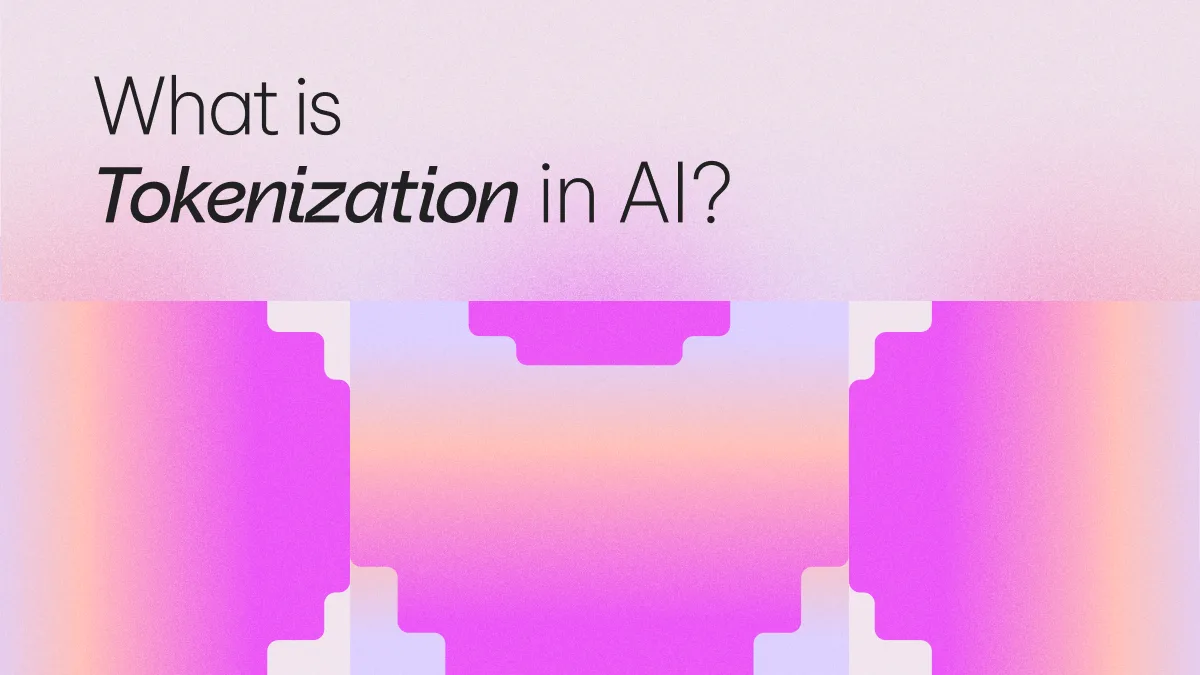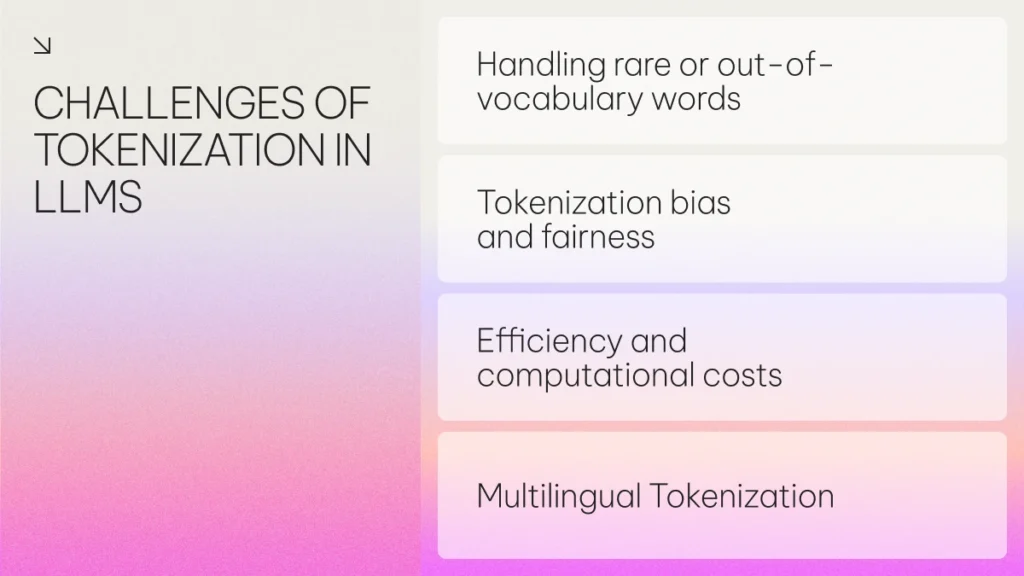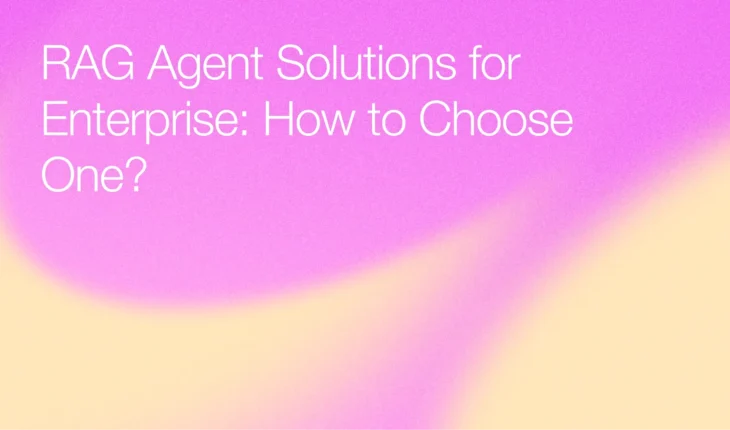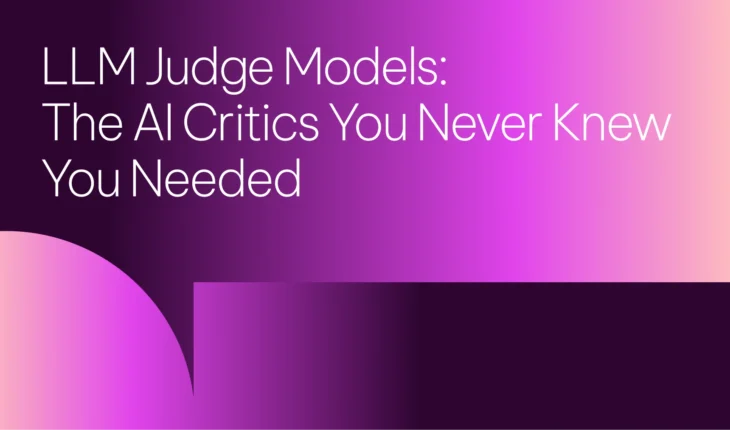Table of Contents

What is Tokenization in AI? Usage, Types, Challenges
More than three-quarters of organizations now use AI in at least one business function, with large companies leading the adoption of generative AI technologies. At the heart of these systems’ accuracy, efficiency, and cost-effectiveness lies a foundational technical process: tokinization.
This often-overlooked mechanism serves as the interface between human language and machine understanding. It transforms our natural communication into a format that computational systems can process mathematically.
In this article, we’ll explore the various methods for implementing this process, their comparative strengths and weaknesses, and how selecting the right approach can optimize both the effectiveness and economics of your AI deployments.
What is AI tokenization?
AI tokenization is the process of converting text into smaller, standardized units called tokens that language models can mathematically process. Depending on the tokenization method used, these tokens can represent whole words, parts of words (subwords), or even individual characters.
This conversion is necessary because AI systems cannot interpret raw text directly. Once tokenized, the text is transformed into numerical IDs and then into vector representations – mathematical formats that express the meaning or context of a word as a series of numbers. These vectors allow the AI model to analyze language in a way it can understand, enabling it to grasp context, identify relationships, and generate appropriate responses.
Why is tokenization essential in NLP and AI?
Tokenization is a foundational step in natural language processing (NLP). It breaks down text into smaller units – such as words, subwords, or characters – so that AI models can understand and generate language.
Without tokenization:
- AI wouldn’t recognize words. Language models need structured input. Without tokenization, words like “email” and “emails” would be seen as entirely unrelated strings of characters, with no understanding of their similarity or shared root.
- Sentences would lose structure. AI wouldn’t know where one word ends and another begins. It would read “theemailisunread” as a single, meaningless string rather than “the email is unread.”
- Processing wouldn’t be possible. Since AI models operate on numbers, they rely on tokenization to assign IDs to each token before converting them into vector representations. Without this step, the model couldn’t interpret or analyze language in any meaningful way.
How do Large Language Models (LLMs) use tokens?
Large Language Models (LLMs) are predictive systems that generate responses by predicting the next token in a sequence. Tokenization is important to this process as it defines the model’s vocabulary and structures the input into a form the model can compute.
When a user submits a prompt, it is first tokenized: the text is split into units (tokens), which may be whole words, subwords, or even individual characters, depending on the tokenizer. Each token is then assigned a unique integer ID.
For example:
Original text: “Was the email sent?”
- Tokens: [“Was”, “the”, “email”, “sent”, “?”]
These token IDs are mapped to vector representations called embeddings, which translate each token into a series of numbers that capture meaning and relationships between words.
For example, embeddings help the model understand that “email” and “emails” are different words but related in meaning – one being a plural form of the other.
These embeddings are what the LLM uses to understand context and generate appropriate responses. They are learned during the model’s training phase but can also be extended or fine-tuned with custom data, making them particularly powerful for enterprise use cases that involve specialized vocabulary.
This transformation from tokens to embeddings happens in milliseconds, but the methods of tokenization and the model’s architecture significantly impact performance. Tokenization determines how much text can fit into the model’s context window – the maximum number of tokens the model can process at once.
Simply put, a longer sequence length and bigger context window give LLMs a broader “memory” of the conversation or document. With a shorter sequence length, the model may lose track of earlier parts of the input, reducing the quality or relevance of its responses.
What are the different types of tokenization?
The three main types of tokenization – word-level, character-level, and subword tokenization – each have advantages and trade-offs.
For example, word-level tokenization is often ideal for enterprises dealing with structured data (e.g., financial reports). In contrast, subword tokenization is recommended for AI chatbots handling multiple languages to ensure adaptability.
Choosing the right method depends on the task, language complexity, and the need to handle rare words. Let’s explore each in more detail.
Word-level tokenization
Word-level tokenization splits text into whole words, making it effective for languages with clear word boundaries, like English.
For example:
Orginal text: “Was the email sent?”
- Tokens: [“Was”, “the”, “email”, “sent”, “?”]
This method has traditionally been used in customer support chatbots, particularly in simpler or rule-based systems, where identifying common phrases like “refund policy” or “order status” could help match user input to predefined responses.
However, word tokenization has limitations – especially in more advanced, open-domain applications. Because it treats each word as a standalone unit, it struggles with unknown or rare words not seen during training. It also lacks the flexibility to handle typos, misspellings, or morphologically complex words.
Word-level tokenization is still useful in more controlled settings, such as domain-specific NLP tasks, text classification with fixed vocabularies, or systems dealing with structured and predictable input, such as a helpdesk ticket categorization system in a company intranet.
Character-level tokenization
Character-level tokenization breaks text down into individual characters, including letters, spaces, punctuation, and symbols. This approach is especially useful for handling typos, unknown words, creative spellings, and multilingual input without requiring language-specific rules.
For example:
Orginal text: “Was the email sent?”
- Tokens: [“W”, “a”, “s”, ” “, “t”, “h”, “e”, ” “, “e”, “m”, “a”, “i”, “l”, ” “, “s”, “e”, “n”, “t”, “?”]
Character-level tokenization is also valuable for tasks requiring fine-grained analysis of text, such as fraud detection or spam filtering, where malicious actors may try to disguise words using subtle misspellings (e.g., “pa$$word” or “ver1fy”).
However, because each character is treated as a separate token, even short sentences produce long token sequences. This increases the computational load and requires larger context windows, making character-level tokenization less efficient for large-scale language models handling long-form text.
Subword-level tokenization
Subword tokenization strikes a balance between word- and character-level methods by breaking text into smaller, meaningful units based on patterns seen during training.
For example:
Orginal text: “Was the email sent?”
- If “email” is common in the training data:
- Tokens: [“Was”, “the”, “email”, “sent”, “?”]
- If “email” is rare or unseen:
- Tokens: [“Was”, “the”, “e”, “##mail”, “sent”, “?”]
Used in models like BERT and GPT, subword tokenization helps handle rare words, typos, and multilingual input by piecing together unfamiliar terms from known subword parts. For instance, a rare term like “telehealthcare” might be tokenized as [“tele”, “health”, “care”], allowing the model to make sense of it even if it’s never seen the full word.
In enterprise applications like search engines or knowledge systems, subword tokenization improves accuracy by capturing variations of industry-specific language. However, because it’s based on statistical frequency – not grammar – it can sometimes misinterpret word structure, such as splitting “reset” into “re” and “set” even when the meaning is not compositional.
Challenges of Tokenization in LLMs
While crucial for enabling LLMs to process text, it introduces several challenges that can impact performance, fairness, and cost – especially in complex or enterprise-level applications.

Handling rare or out-of-vocabulary words
One challenge is dealing with words or phrases that the model hasn’t seen often in training. Even though modern models can break these into smaller, familiar parts, this can affect accuracy. In industries like finance or healthcare, where specialized terms are common, this becomes more noticeable.
For example, a model might split the word “preauthorization” (common in healthcare) into smaller parts like “pre”, “author”, and “ization”, which could affect how the system understands its meaning. These longer sequences also use more tokens, which increases processing time and cost.
Tokenization bias and fairness
Tokenization can introduce bias based on how words are split and which word patterns are prioritized. This often stems from the training data used to build the tokenizer.
The way a model breaks down words depends on the language and examples it was exposed to during training. If most of the data came from widely spoken languages or dominant social groups, the tokenizer may not handle text from underrepresented communities or niche industries as effectively.
This can lead to awkward or inaccurate token splits — especially for cultural terms, names, or industry-specific language in fields like finance or healthcare.
Efficiency and computational costs
Tokenization also affects how efficiently a model runs. The more tokens a sentence is split into, the more computing power is needed – and most AI platforms charge based on how many tokens are processed.
For instance, in retail, customer queries like “Do you have any buy-one-get-one-free promotions?” may be broken into many tokens, especially if phrased informally or with typos. This increases costs, especially at scale, or when handling thousands of interactions in a support system.
Choosing the right tokenization method is key to controlling performance and cost in large-scale deployments.
Multilingual Tokenization Challenges
Tokenization becomes more complex when models are used across multiple languages. Each language has its own rules and structure, and a tokenizer trained mostly on English may not handle other scripts as effectively.
In some languages – such as Arabic or Finnish – a single root word can take on many different forms depending on grammar, tense, or case. This is called morphological richness. In healthcare, for example, a root like “diagnos” might appear as “diagnosis,” “diagnosed,” “diagnostic,” or “diagnoses.” If the tokenizer treats these as entirely unrelated tokens, the model may miss the connection between them, reducing its understanding of medical context or intent.
Tokenization in your enterprise
Tokenization plays a pivotal role in the reliability, performance, and cost-efficiency of generative AI applications. Choosing the right tokenization approach – and understanding how your data is being segmented – can lead to more accurate outputs and significant cost savings.
In practice, prompt engineering is a key strategy to reduce the number of unnecessary tokens sent to the model, improving both speed and affordability. Separately, organizations may also explore model compression techniques – such as quantization or distillation – to reduce infrastructure costs at the inference level.
By understanding how tokens are used in your enterprise setting, you can better align AI systems with specific business requirements, improve language handling in specialized domains, and enhance the efficiency of your deployments. While tokenization alone doesn’t eliminate bias, tailoring your data and prompts can support more inclusive and accurate outcomes.
FAQs
-
Many LLM providers charge based on the number of tokens processed for both input and output. The way text is tokenized affects how many tokens are used to represent the same content. Some methods break text into smaller units, resulting in more tokens – and therefore, higher costs. Tokenization also impacts how much information a model can retain in its context window, which can affect performance and price.
-
Languages differ in structure – some, like Chinese and Japanese, don’t use spaces between words, while others, like Arabic or Finnish, allow many variations of the same root word. If the tokenizer wasn’t designed or trained with these language characteristics in mind, it may struggle to process the text correctly. This can lead to misunderstandings or introduce bias, especially in underrepresented languages.


